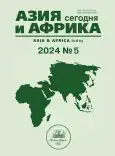From Ne Win to Min Aung Hlain: Astrology, Numerology and Apotropaic Rituals as a Part of Myanmar Military Elites Policy
- Autores: Zaitsev I.A1
-
Afiliações:
- IMEMO
- Edição: Nº 5 (2024)
- Páginas: 23-31
- Seção: Politics, economics
- URL: https://journals.rcsi.science/0321-5075/article/view/257200
- DOI: https://doi.org/10.31857/S032150750030846-2
- ID: 257200
Citar
Texto integral
Resumo
Palavras-chave
Sobre autores
I. Zaitsev
IMEMO
Email: kouaun6803@gmail.com
ORCID ID: 0000-0002-0883-059X
Junior Researcher Moscow, Russia
Bibliografia
- Tambiah S. 1976. World conqueror and world renouncer. A Study of Buddhism and Polity in Thailand against a Historical Background. Cambridge: University Press.
- Matthews B. 1998. The Present Fortune of Tradition-Bound Authoritarianism in Myanmar. Pacific Affairs. Vol. 71. Pp. 7–23.
- Mendelson M. 1975. Sangha and State in Burma: a Study of Monastic Sectarianism and Leadership. Ithaca: Cornell University Press.
- Leehey J. 2010. Open Secrets, Hidden meanings: censorship, esoteric power, and contested authority in Urban Burma in the 1990s. A dissertation submitted in partial fulfillment for the degree of doctor of philosophy. University of Washington.
- Walton M. 2016. Buddhism, Politics, and Political Thought in Myanmar. New York: Cambridge University Press
- Gravers M. 1999. Nationalism as political paranoia in Burma: an essay on the historical practice of power. New York: Curzon University Press.
- Candier A., Ferguson J. 2008. Astrological and Divinatory Practices in Burma: Mapping the beidin Category. Journal of Burma Studies. Vol. 26. Pp. 147–159.
- Heine-Geldern R. Conceptions of State and kingship in Southeast Asia. Far Eastern Quarterly. Vol. 2. Pp. 15–30
- Lieberman V. 1987. Reinterpreting Burmese History. Comparative Studies in Society and History. Vol. 29. Pp. 162–194.
- Than Tun. 1960. The Influence of Occultism in Burmese History with Special Reference to Bodawphaya’s Reign. Bulletin of the Burma Historical Commission. Vol. 1. № 2. Pp. 117–145.
- Foxeus N. 2023. Buddhist Nationalist Sermons in Myanmar: Anti-Muslim Moral Panic, Conspiracy Theories, and Socio-Cultural Legacies. Journal of Contemporary Asia. Vol. 53. Pp. 423–449
- Spiro M. 1970. Buddhism and Society. A Great tradition and Its Burmese Vicissitudes. New York: Harper & Row Publishers
- Nakanishi Y. 2013. Strong Soldiers, Failed Revolution. The State and Military in Burma, 1962-88. Singapore: NUS Press.
- Taylor R. 2015. General Ne Win. A Political Biography. Singapore: ISEAS Publishing.
- Maung Mya. 1992. Totalitarianism in Burma: Prospects for Economic Development. New York: Paragon House.
- Schober J. 2011. Modern Buddhist Conjunctures in Myanmar: Cultural Narratives, Colonial Legacies, and Civil Society. Honululu: University of Hawaii Press.
- Salem-Gervais N., Zar Nie R. 2012. A Textbook Case of Nation-Building: The Evolution of History Curricula in Myanmar. Journal of Burma Studies. June, Vol. 16. № 1. Pp. 27–78.
- Engelkamp S. 2008. Moral Authority in Burmese Politics. ASIEN. The German Journal of Contemporary Asia. Vol. 109. Pp. 37–53
- Rogers B., Woodrum J. 2010. Than Shwe: Unmasking Burma’s Tyrant. Silkworm Books.
- Min Aung Hlaing uses military version of ‘democracy’ as tool to maintain power. Mizzima. News from Myanmar. 2024. April 14. https://eng.mizzima.com/2024/02/12/7086 (accessed 14.04.2024)
Arquivos suplementares










